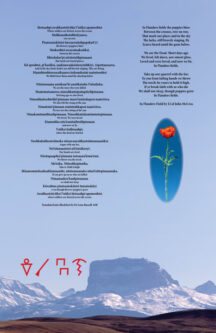Blackfoot translation of ‘In Flanders Fields’ honours Indigenous veterans
By Alejandra Pulido-Guzman - LETHBRIDGE HERALD on November 9, 2021.
 Glenn Miller/ Lena Russell
Glenn Miller/ Lena RussellLETHBRIDGE HERALDapulido@lethbridgeherald.com
A poster of John McCrae’s famous First World War poem “In Flanders Fields” has been created in both the Blackfoot and English language by local veteran Glenn Miller, in collaboration of Blood Tribe member Lena Russell, to help recognize National Indigenous Veterans Day.
“Indigenous veterans were involved in World War One, World War Two, Korea and even Afghanistan currently today. Many Canadians don’t know some of the injustices done to the indigenous veterans when they returned, and some of the trials and tribulations they had to fight for and try to rectify and continue to fight for today,” said Miller.
This poem is the result of Miller helping with the Blood Tribe Remembrance Day service, as he spoke at their ceremony in Standoff about their warriors.
“As a gift to the nation, I presented a plaque of the poem In Flanders Field, but that plaque is from the original printing plate, which is held at the Royal Canadian Artillery Museum in Shilo and that plater has since cracked, so there wont be any more prints made of it so it’s a pretty rare edition,”said Miller.
From there Lena Russell has transcribed the poem In Flanders Fields into Blackfoot. It was her desire that the next generation of youth will be able to recite that poem in their Blackfoot language.
“I produced this with a goal in mind a couple of years ago, to help fulfill her wish,” said Miller.
Russell had produced it in Blackfoot and Miller put the English subtitles and gave it back to the Russell family for review.
The 24 x 36 inches poster consists of the poem In Flanders Fields, both in English and Blackfoot, as well as an English translation underneath the Blackfoot text, to help educate those who are learning blackfoot as it is not a literal translation due to the fact that Blackfoot language is a very oral and descriptive language.
The poster features a picture of Chief Mountain, which is a very sacred mountain to the Blackfoot, and four symbols located at the bottom of the poster which are used uniquely by warriors.
Miller explained the symbols from left to right. The first one is a warrior symbol. The second one is a gun, because if they would capture a gun it was a high honour. Third symbol is a leader symbol, if someone lead a raid they could use one of those symbols. And the last one is a Scout, the zig zag line whether it is straight or curvy, symbolizes the scout who would observe the enemy and then go back to his friendly people and report, but he wouldn’t take a direct line, he would go back and forth to confuse anybody who might be following him.
These symbols were provided by elders of the Blood Tribe and they suggested the specific order from left to right as they are in order of hierarchy.
The poem was sent over in Blackfoot to the Liberation Museum in Lochem, The Netherlands, where it is on display as a tribute to Indigenous veterans who helped in the liberation of their country during the Second World War. The bilingual version of the poster was recently sent electronically to the museum to be updated for visitors.
Miller presented the poster on Monday to Russell’s daughter Blood Tribe councillor Maria Russell.
Follow @APulidoHerald on Twitter
4-3


